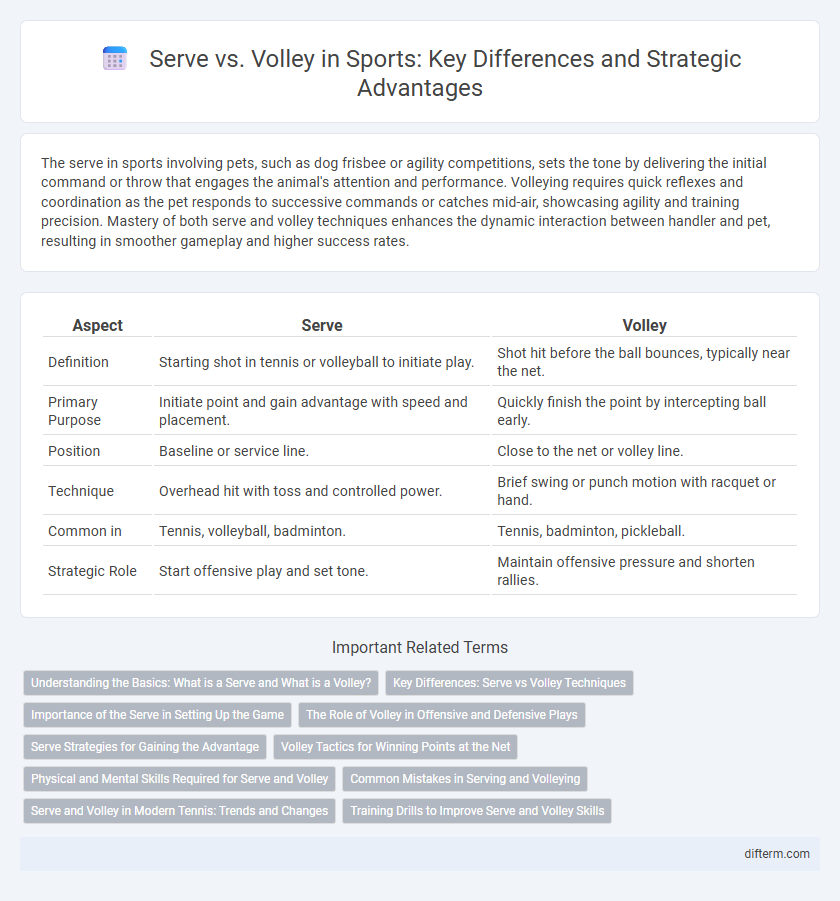The serve in sports involving pets, such as dog frisbee or agility competitions, sets the tone by delivering the initial command or throw that engages the animal's attention and performance. Volleying requires quick reflexes and coordination as the pet responds to successive commands or catches mid-air, showcasing agility and training precision. Mastery of both serve and volley techniques enhances the dynamic interaction between handler and pet, resulting in smoother gameplay and higher success rates.
Table of Comparison
| Aspect | Serve | Volley |
|---|---|---|
| Definition | Starting shot in tennis or volleyball to initiate play. | Shot hit before the ball bounces, typically near the net. |
| Primary Purpose | Initiate point and gain advantage with speed and placement. | Quickly finish the point by intercepting ball early. |
| Position | Baseline or service line. | Close to the net or volley line. |
| Technique | Overhead hit with toss and controlled power. | Brief swing or punch motion with racquet or hand. |
| Common in | Tennis, volleyball, badminton. | Tennis, badminton, pickleball. |
| Strategic Role | Start offensive play and set tone. | Maintain offensive pressure and shorten rallies. |
Understanding the Basics: What is a Serve and What is a Volley?
A serve is the initial shot that starts a tennis point, where the player strikes the ball from behind the baseline into the opponent's service box. A volley occurs when a player hits the ball in midair before it bounces, typically near the net, aiming to cut off the opponent's return and gain control of the point. Mastering the serve and volley techniques is essential for effective offensive strategy and court positioning in tennis.
Key Differences: Serve vs Volley Techniques
Serve techniques in tennis emphasize generating power and accuracy from a stationary position behind the baseline, involving a precise ball toss and a fluid overhead motion. Volley techniques prioritize quick reflexes and positioning near the net, using short, controlled swings to intercept the ball before it bounces. The serve initiates the point with a focus on spin and placement, while the volley aims to quickly end the rally with sharp, angled shots.
Importance of the Serve in Setting Up the Game
The serve is a critical shot in tennis that sets the tone for each point, allowing players to dictate play from the outset. A powerful and well-placed serve can force weak returns, creating opportunities to approach the net and execute effective volleys. Mastering the serve increases a player's chances of controlling rallies, thus enhancing overall match performance.
The Role of Volley in Offensive and Defensive Plays
Volley plays a crucial role in both offensive and defensive strategies, allowing players to take control of the net and apply pressure on opponents. By intercepting the ball early, volleys reduce reaction time for adversaries and create opportunities to finish points quickly. Effective volleying enhances court positioning, disrupts baseline rallies, and can turn defensive moments into offensive advantages.
Serve Strategies for Gaining the Advantage
Effective serve strategies in tennis involve varying serve speed, spin, and placement to disrupt the opponent's rhythm and create weak returns. Targeting the opponent's backhand or the T-area can generate immediate offensive opportunities, facilitating aggressive net approaches. Consistently mixing slice, flat, and kick serves enhances unpredictability, increasing the chance of winning quick points and setting up decisive volleys.
Volley Tactics for Winning Points at the Net
Volley tactics for winning points at the net emphasize quick reflexes, precise positioning, and strategic shot placement to outmaneuver opponents. Effective volleys exploit opponents' weak returns by targeting open spaces and applying constant pressure, forcing errors or weak replies. Mastering split-step timing and maintaining an aggressive stance increases the likelihood of intercepting shots early and controlling the net.
Physical and Mental Skills Required for Serve and Volley
Serve and volley demands explosive physical agility, precise hand-eye coordination, and strong leg muscles to quickly transition from the baseline to the net. Mental skills include sharp focus to anticipate opponents' returns, strategic decision-making to time volleys effectively, and resilience under pressure during fast-paced exchanges. Mastery of serve and volley enhances both power and reflexes, essential for dominating points in tennis.
Common Mistakes in Serving and Volleying
Common mistakes in serving include poor ball toss consistency and inadequate racquet acceleration, leading to weak or inaccurate serves. In volleying, players often err by not positioning themselves close enough to the net, resulting in insufficient control and reaction time against fast shots. Mastering balance and timing directly improves overall effectiveness in both serving and volleying strategies.
Serve and Volley in Modern Tennis: Trends and Changes
Serve and volley in modern tennis has declined due to improvements in baseline play and racket technology favoring powerful groundstrokes. Despite this, players like Roger Federer and Pete Sampras have demonstrated the effectiveness of a well-timed serve and volley strategy on faster surfaces such as grass courts. Recent trends indicate a tactical resurgence in serve and volley during tie-breaks or against opponents with weak returns, highlighting its situational value in contemporary matches.
Training Drills to Improve Serve and Volley Skills
Training drills to improve serve and volley skills focus on enhancing reaction time, footwork, and shot accuracy. Practicing short and aggressive serves followed by quick advances to the net sharpens players' ability to transition smoothly between serving and volleying. Incorporating target-based drills and simulated match scenarios helps develop consistency and strategic positioning during high-pressure points.
serve vs volley Infographic

 difterm.com
difterm.com